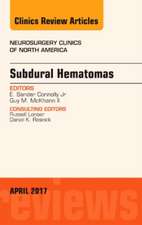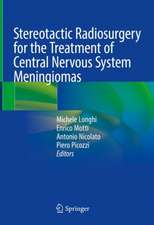Contemporary Skull Base Surgery: A Comprehensive Guide to Functional Preservation
Editat de A. Samy Youssefen Limba Engleză Hardback – 6 iul 2022
The first section details the general principles that every skull base surgeon needs to be acquainted with - skull base anatomy, developing a multidisciplinary skull base team, operating room equipment, surgical instruments, and modern imaging technologies. These are the key elements that play a major role in optimizing functional outcomes and patients’ quality of life. Following this, the compartmental anatomy chapters set the stage for understanding the technical and surgical nuances of each location.
The subsequent five sections are organized as anatomical compartments or regions of the skull base. Every region is organized in the same format for uniformity and ease of use. Each section includes the available treatment choices to each compartment, and describes the relevant pathologies. The contribution of worldwide leaders including neurosurgeons and otolaryngologists provides top-level expertise in how to tackle each pathology.
The surgical approaches chapters that lead each anatomical section describe operative techniques in a clear. stepwise fashion with accompanying intra-operative photos and surgical videos. In the individual pathology chapters, different pathological subtypes are described with representative radiographic images of clinical case examples. Accompanying each pathology is a treatment algorithm based on tumor morphology, pre-operative clinical status, and the goal of maximum functional preservation with a brief description of surgical approaches. This will serve as a roadmap that will help the reader to easily reach a decision of how to treat each skull base pathology.
The general theme is functional and anatomical preservation of key neurovascular structures. Setting such structures as a target and planning an approach that minimizes iatrogenic damage to these structures will lead the surgeon down the road of either open, endoscopic, or a combination of both approaches.
A comprehensive book that is versatile to serve as a handbook as well as a detailed reference for skull base surgery does not currently exist. In addition, combining the two main surgical schools represented by endoscopy and open surgery into one reference enhanced by treatment algorithms is another unique feature.
| Toate formatele și edițiile | Preț | Express |
|---|---|---|
| Paperback (1) | 1140.96 lei 6-8 săpt. | |
| Springer International Publishing – 6 iul 2023 | 1140.96 lei 6-8 săpt. | |
| Hardback (1) | 1376.22 lei 39-44 zile | |
| Springer International Publishing – 6 iul 2022 | 1376.22 lei 39-44 zile |
Preț: 1376.22 lei
Preț vechi: 1448.65 lei
-5% Nou
Puncte Express: 2064
Preț estimativ în valută:
263.35€ • 281.60$ • 219.57£
263.35€ • 281.60$ • 219.57£
Carte tipărită la comandă
Livrare economică 14-19 aprilie
Preluare comenzi: 021 569.72.76
Specificații
ISBN-13: 9783030993207
ISBN-10: 3030993205
Pagini: 817
Ilustrații: XXV, 817 p. 404 illus., 314 illus. in color.
Dimensiuni: 178 x 254 mm
Greutate: 1.96 kg
Ediția:1st ed. 2022
Editura: Springer International Publishing
Colecția Springer
Locul publicării:Cham, Switzerland
ISBN-10: 3030993205
Pagini: 817
Ilustrații: XXV, 817 p. 404 illus., 314 illus. in color.
Dimensiuni: 178 x 254 mm
Greutate: 1.96 kg
Ediția:1st ed. 2022
Editura: Springer International Publishing
Colecția Springer
Locul publicării:Cham, Switzerland
Cuprins
Evolution of the Multidisciplinary Skull Base Team.- Surgical Anatomy of Cranial Nerves.- Compartmental Anatomy: Microsurgical and Endoscopic.- The Operating Room.- Surgical Positioning.- Cranial Nerve Functional Preservation: Tricks of the Trade.- Neurophysiologic Monitoring.- Microdissection Tools.- Neuroimaging Precision Tools.- Skull Base Reconstruction.- Role of Radiotherapy in Modern Skull Base Surgery.- Cerebral Revascularization.- Cranial Nerve Repair and Rehabilitation.- Open Surgical Approaches.- Endoscopic Endonasal Approaches.- Keyhole Approaches.- Meningioma.- Craniopharyngioma.- Pituitary Adenoma.- Sinonasal Cancer.- Surgical Approaches: Open and Endoscopic.- Meningioma.- Pituitary Adenoma.- Schwannoma.- Chordoma and Chondrosarcoma.- Open Surgical Approaches.- Endoscopic Endonasal Approaches.- Trigeminal Schwannoma.- Middle fossa Approach for Hearing Preservation.- Expanded Middle Fossa Approach: Anterior Petrosectomy.- Pretemporal Transcavernous Approach.- Endoscopic Endonasal Transcavernous Approach.- Open Surgical Approaches.- Endoscopic Endonasal Transpterygoid Approaches.- Keyhole Approaches.- Petroclival Meningioma.- Vestibular Schwannoma.- Cerebellopontine Angle Epidermoid Tumor.- Chordoma and Chondrosarcoma.- Pineal Tumors.- Open Surgical Approaches.- Endoscopic Endonasal Approaches.- Meningioma.- Schwannoma.- Paraganglioma.- Chondrosarcoma.- Open Approaches.- Endoscopic Endonasal Approaches.- Paraganglioma.- Juvenile nasopharyngeal Angiomas.- Schwannoma.
Notă biografică
A. Samy Youssef, MD, PhD
Professor of Neurosurgery and Otolaryngology
Vice Chairman
Director of Skull Base Surgery
University of Colorado School of Medicine
12631 E. 17th Ave
Aurora, CO 80045
P: 303-724-2305
F: 303-724-2300
Samy.youssef@cuanschutz.edu
Dr Youssef completed his neurosurgery residency at the prestigious Ain-Shams University in Cairo, Egypt. He completed his residency in 2001 during which time he was able to complete a PhD in the Neurosciences through a joint program with Hahnemann University in Philadelphia. Dr Youssef also completed a two-year pediatric neurosurgery fellowship at Hahnemann University during the mid-portion of his neurosurgical training. Following graduation, he completed two fellowships in skull base surgery, the first at the University of Cincinnati from 2001-2002 and the second at the University of South Florida from 2002-2003, which included a fellowship in cerebrovascular surgery as well. With a desire to continue his medical career in the United States he entered into a second neurosurgical residency at the University of South Florida. He completed this residency in 2008 and joined the department for 6 years as a faculty member at the University of South Florida, rising from the rank of Assistant to Associate Professor. Dr Youssef joined the Department of Neurosurgery at the University of Colorado as director of the skull base program in June of 2014. Currently he’s a Professor of Neurosurgery and Otolaryngology and Fellowship program director. He is vice chairman for education and director of the skull base surgery program.
He holds patents covering both novel surgical techniques and instrumentation for complex skull surgery. The Youssef Cranial Nerve Dissector set is another addition to comprehensive skull base instrument sets. His research both in the laboratory and in the operating room have resulted in multiple publications and patents. He is the author of over 100 publications including peer-review, abstracts and book chapters. Dr Youssef has given over 150 presentations nationally and internationally.
Dr Youssef’s interest is in the combined endoscopic and microsurgery techniques to further develop lesser invasive surgery in our field.
Textul de pe ultima copertă
This text is designed to function as a comprehensive guide/companion that will not only facilitate the decision-making process for the surgeon, but also help young surgeons build a successful career in skull base surgery. It is divided into six main sections:
The first section details the general principles that every skull base surgeon needs to be acquainted with - skull base anatomy, developing a multidisciplinary skull base team, operating room equipment, surgical instruments, and modern imaging technologies. These are the key elements that play a major role in optimizing functional outcomes and patients’ quality of life. Following this, the compartmental anatomy chapters set the stage for understanding the technical and surgical nuances of each location.
The subsequent five sections are organized as anatomical compartments or regions of the skull base. Every region is organized in the same format for uniformity and ease of use. Each section includes the available treatment choices to each compartment, and describes the relevant pathologies. The contribution of worldwide leaders including neurosurgeons and otolaryngologists provides top-level expertise in how to tackle each pathology.The surgical approaches chapters that lead each anatomical section describe operative techniques in a clear. stepwise fashion with accompanying intra-operative photos and surgical videos. In the individual pathology chapters, different pathological subtypes are described with representative radiographic images of clinical case examples. Accompanying each pathology is a treatment algorithm based on tumor morphology, pre-operative clinical status, and the goal of maximum functional preservation with a brief description of surgical approaches. This will serve as a roadmap that will help the reader to easily reach a decision of how to treat each skull base pathology. The general theme is functional and anatomical preservation of key neurovascular structures. Setting such structures as a target and planning an approach that minimizes iatrogenic damage to these structures will lead the surgeon down the road of either open, endoscopic, or a combination of both approaches.
A comprehensive book that is versatile to serve as a handbook as well as a detailed reference for skull base surgery does not currently exist. In addition, combining the two main surgical schools represented by endoscopy and open surgery into one reference enhanced by treatment algorithms is another unique feature.
The first section details the general principles that every skull base surgeon needs to be acquainted with - skull base anatomy, developing a multidisciplinary skull base team, operating room equipment, surgical instruments, and modern imaging technologies. These are the key elements that play a major role in optimizing functional outcomes and patients’ quality of life. Following this, the compartmental anatomy chapters set the stage for understanding the technical and surgical nuances of each location.
The subsequent five sections are organized as anatomical compartments or regions of the skull base. Every region is organized in the same format for uniformity and ease of use. Each section includes the available treatment choices to each compartment, and describes the relevant pathologies. The contribution of worldwide leaders including neurosurgeons and otolaryngologists provides top-level expertise in how to tackle each pathology.The surgical approaches chapters that lead each anatomical section describe operative techniques in a clear. stepwise fashion with accompanying intra-operative photos and surgical videos. In the individual pathology chapters, different pathological subtypes are described with representative radiographic images of clinical case examples. Accompanying each pathology is a treatment algorithm based on tumor morphology, pre-operative clinical status, and the goal of maximum functional preservation with a brief description of surgical approaches. This will serve as a roadmap that will help the reader to easily reach a decision of how to treat each skull base pathology. The general theme is functional and anatomical preservation of key neurovascular structures. Setting such structures as a target and planning an approach that minimizes iatrogenic damage to these structures will lead the surgeon down the road of either open, endoscopic, or a combination of both approaches.
A comprehensive book that is versatile to serve as a handbook as well as a detailed reference for skull base surgery does not currently exist. In addition, combining the two main surgical schools represented by endoscopy and open surgery into one reference enhanced by treatment algorithms is another unique feature.
Caracteristici
Inclusive of both open and endoscopic approaches to the skull base
Operative techniques described in a clear. stepwise fashion
Written by experts in the field
Operative techniques described in a clear. stepwise fashion
Written by experts in the field




















